Analyzing Communication Barriers and Strategies at Sport Love
VerifiedAdded on 2020/12/29
|7
|1482
|477
Report
AI Summary
This report analyzes the communication challenges faced by Sport Love, focusing on the barriers impacting effective communication within the organization. It identifies physical and perceptual barriers, along with challenges like lack of planning and unclear purpose. The report proposes strategies for overcoming these barriers, including clarifying ideas, tailoring communication to the receiver, and being mindful of language and tone. Furthermore, it explores the influence of cultural factors on communication and negotiation styles. The report concludes with a summary of the key issues and strategies for improving communication within Sport Love, highlighting the importance of effective communication for the organization's success. The assignment references various academic sources to support its findings and recommendations.
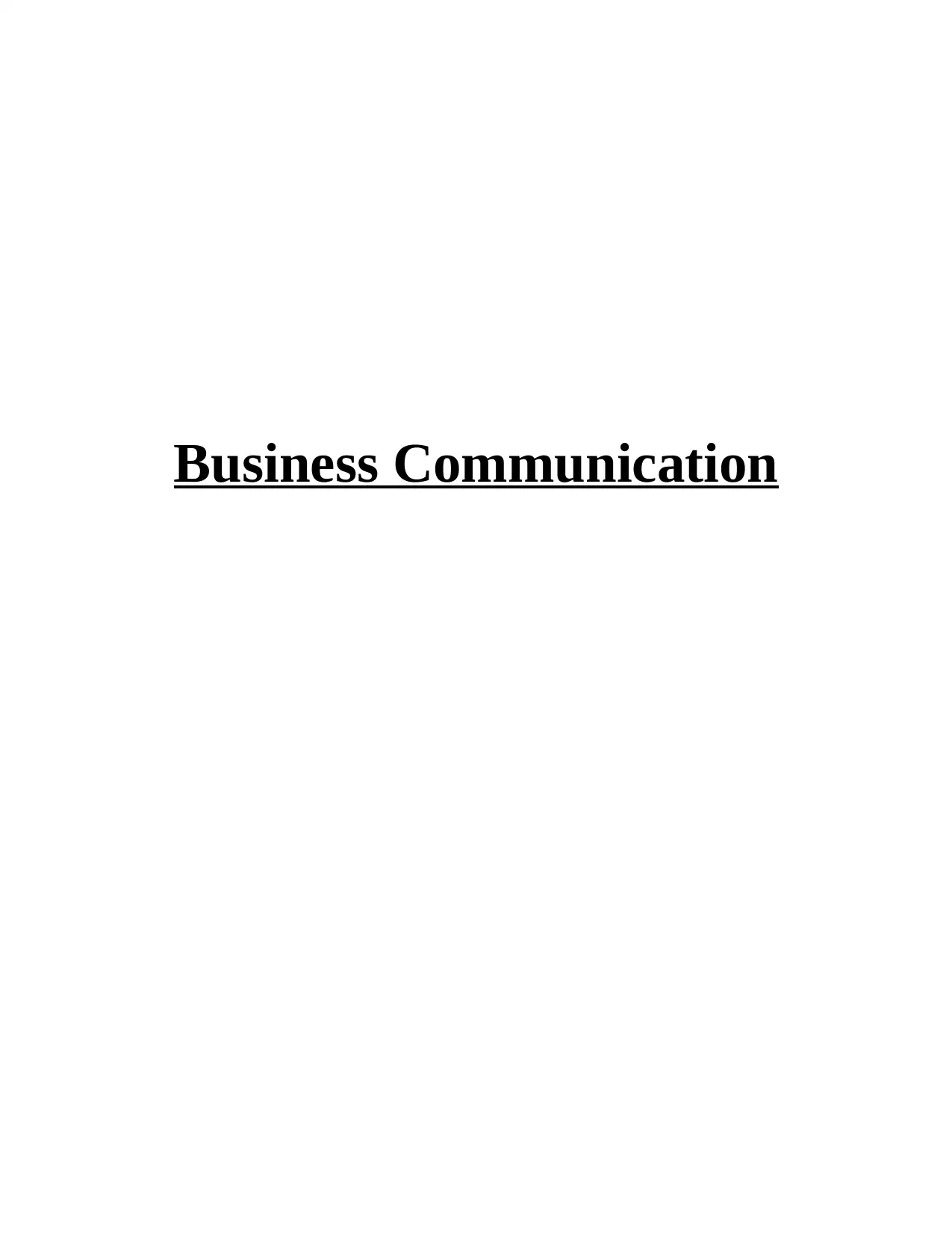
Business Communication
Paraphrase This Document
Need a fresh take? Get an instant paraphrase of this document with our AI Paraphraser
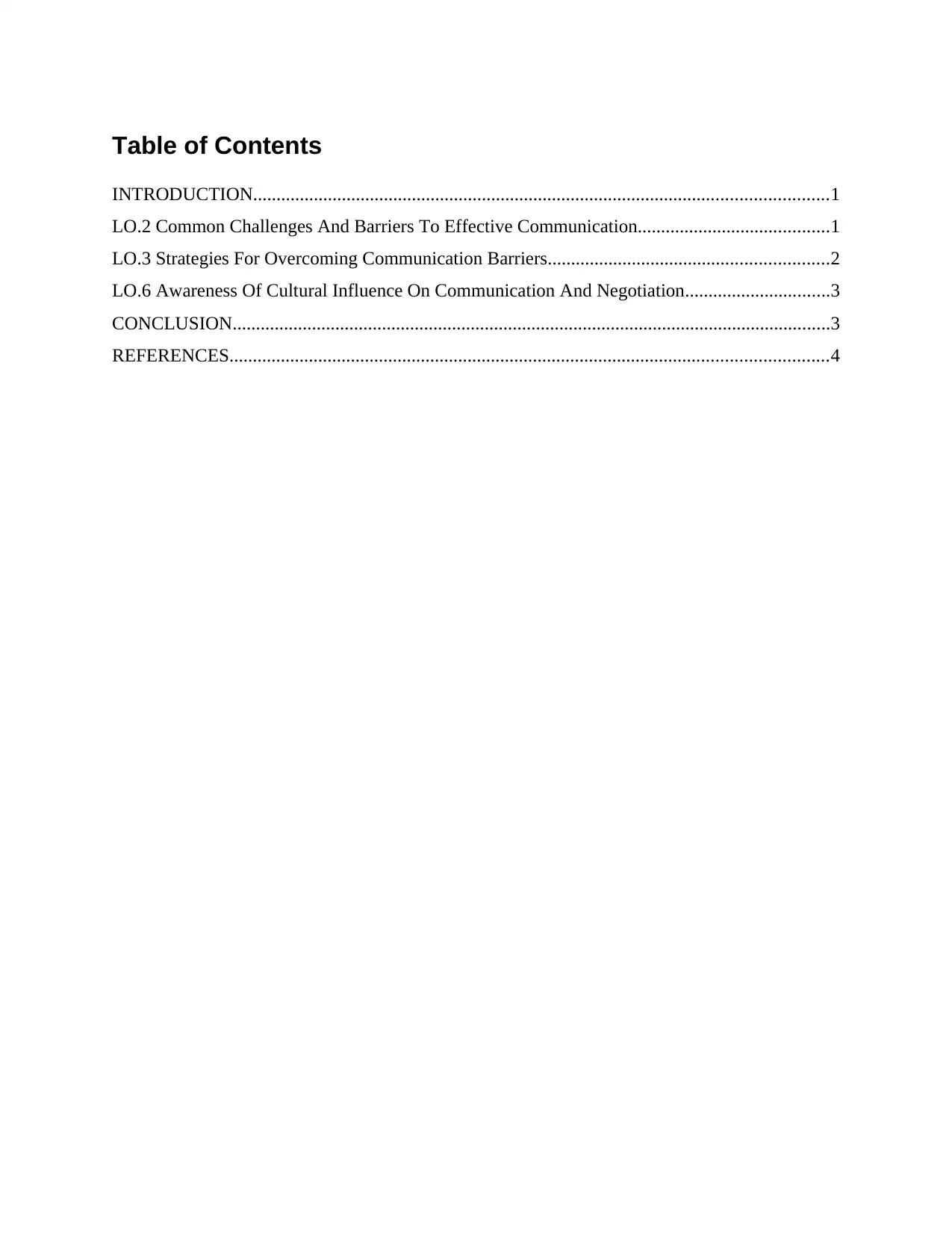
Table of Contents
INTRODUCTION...........................................................................................................................1
LO.2 Common Challenges And Barriers To Effective Communication.........................................1
LO.3 Strategies For Overcoming Communication Barriers............................................................2
LO.6 Awareness Of Cultural Influence On Communication And Negotiation...............................3
CONCLUSION................................................................................................................................3
REFERENCES................................................................................................................................4
INTRODUCTION...........................................................................................................................1
LO.2 Common Challenges And Barriers To Effective Communication.........................................1
LO.3 Strategies For Overcoming Communication Barriers............................................................2
LO.6 Awareness Of Cultural Influence On Communication And Negotiation...............................3
CONCLUSION................................................................................................................................3
REFERENCES................................................................................................................................4
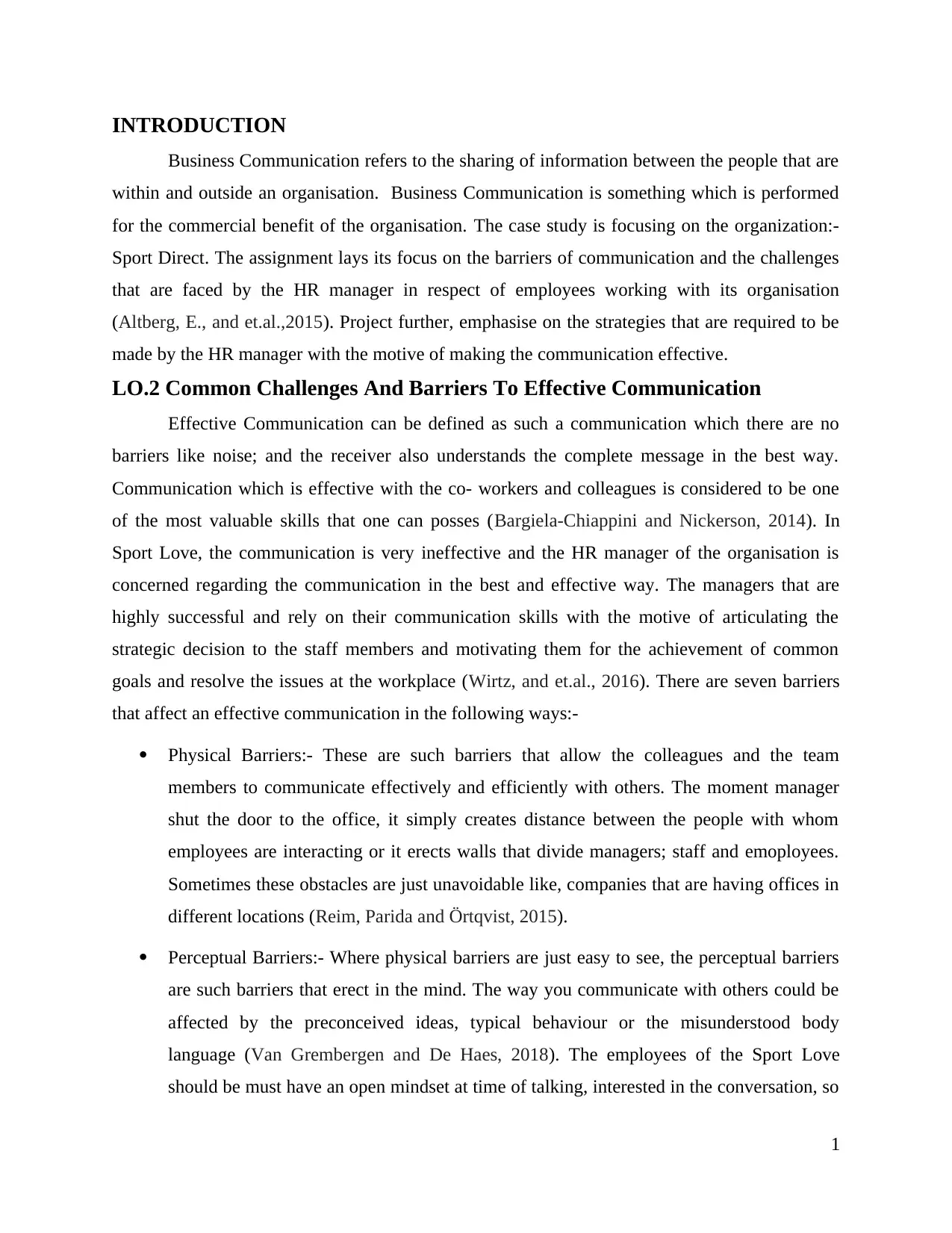
INTRODUCTION
Business Communication refers to the sharing of information between the people that are
within and outside an organisation. Business Communication is something which is performed
for the commercial benefit of the organisation. The case study is focusing on the organization:-
Sport Direct. The assignment lays its focus on the barriers of communication and the challenges
that are faced by the HR manager in respect of employees working with its organisation
(Altberg, E., and et.al.,2015). Project further, emphasise on the strategies that are required to be
made by the HR manager with the motive of making the communication effective.
LO.2 Common Challenges And Barriers To Effective Communication
Effective Communication can be defined as such a communication which there are no
barriers like noise; and the receiver also understands the complete message in the best way.
Communication which is effective with the co- workers and colleagues is considered to be one
of the most valuable skills that one can posses (Bargiela-Chiappini and Nickerson, 2014). In
Sport Love, the communication is very ineffective and the HR manager of the organisation is
concerned regarding the communication in the best and effective way. The managers that are
highly successful and rely on their communication skills with the motive of articulating the
strategic decision to the staff members and motivating them for the achievement of common
goals and resolve the issues at the workplace (Wirtz, and et.al., 2016). There are seven barriers
that affect an effective communication in the following ways:-
Physical Barriers:- These are such barriers that allow the colleagues and the team
members to communicate effectively and efficiently with others. The moment manager
shut the door to the office, it simply creates distance between the people with whom
employees are interacting or it erects walls that divide managers; staff and emoployees.
Sometimes these obstacles are just unavoidable like, companies that are having offices in
different locations (Reim, Parida and Örtqvist, 2015).
Perceptual Barriers:- Where physical barriers are just easy to see, the perceptual barriers
are such barriers that erect in the mind. The way you communicate with others could be
affected by the preconceived ideas, typical behaviour or the misunderstood body
language (Van Grembergen and De Haes, 2018). The employees of the Sport Love
should be must have an open mindset at time of talking, interested in the conversation, so
1
Business Communication refers to the sharing of information between the people that are
within and outside an organisation. Business Communication is something which is performed
for the commercial benefit of the organisation. The case study is focusing on the organization:-
Sport Direct. The assignment lays its focus on the barriers of communication and the challenges
that are faced by the HR manager in respect of employees working with its organisation
(Altberg, E., and et.al.,2015). Project further, emphasise on the strategies that are required to be
made by the HR manager with the motive of making the communication effective.
LO.2 Common Challenges And Barriers To Effective Communication
Effective Communication can be defined as such a communication which there are no
barriers like noise; and the receiver also understands the complete message in the best way.
Communication which is effective with the co- workers and colleagues is considered to be one
of the most valuable skills that one can posses (Bargiela-Chiappini and Nickerson, 2014). In
Sport Love, the communication is very ineffective and the HR manager of the organisation is
concerned regarding the communication in the best and effective way. The managers that are
highly successful and rely on their communication skills with the motive of articulating the
strategic decision to the staff members and motivating them for the achievement of common
goals and resolve the issues at the workplace (Wirtz, and et.al., 2016). There are seven barriers
that affect an effective communication in the following ways:-
Physical Barriers:- These are such barriers that allow the colleagues and the team
members to communicate effectively and efficiently with others. The moment manager
shut the door to the office, it simply creates distance between the people with whom
employees are interacting or it erects walls that divide managers; staff and emoployees.
Sometimes these obstacles are just unavoidable like, companies that are having offices in
different locations (Reim, Parida and Örtqvist, 2015).
Perceptual Barriers:- Where physical barriers are just easy to see, the perceptual barriers
are such barriers that erect in the mind. The way you communicate with others could be
affected by the preconceived ideas, typical behaviour or the misunderstood body
language (Van Grembergen and De Haes, 2018). The employees of the Sport Love
should be must have an open mindset at time of talking, interested in the conversation, so
1
⊘ This is a preview!⊘
Do you want full access?
Subscribe today to unlock all pages.

Trusted by 1+ million students worldwide
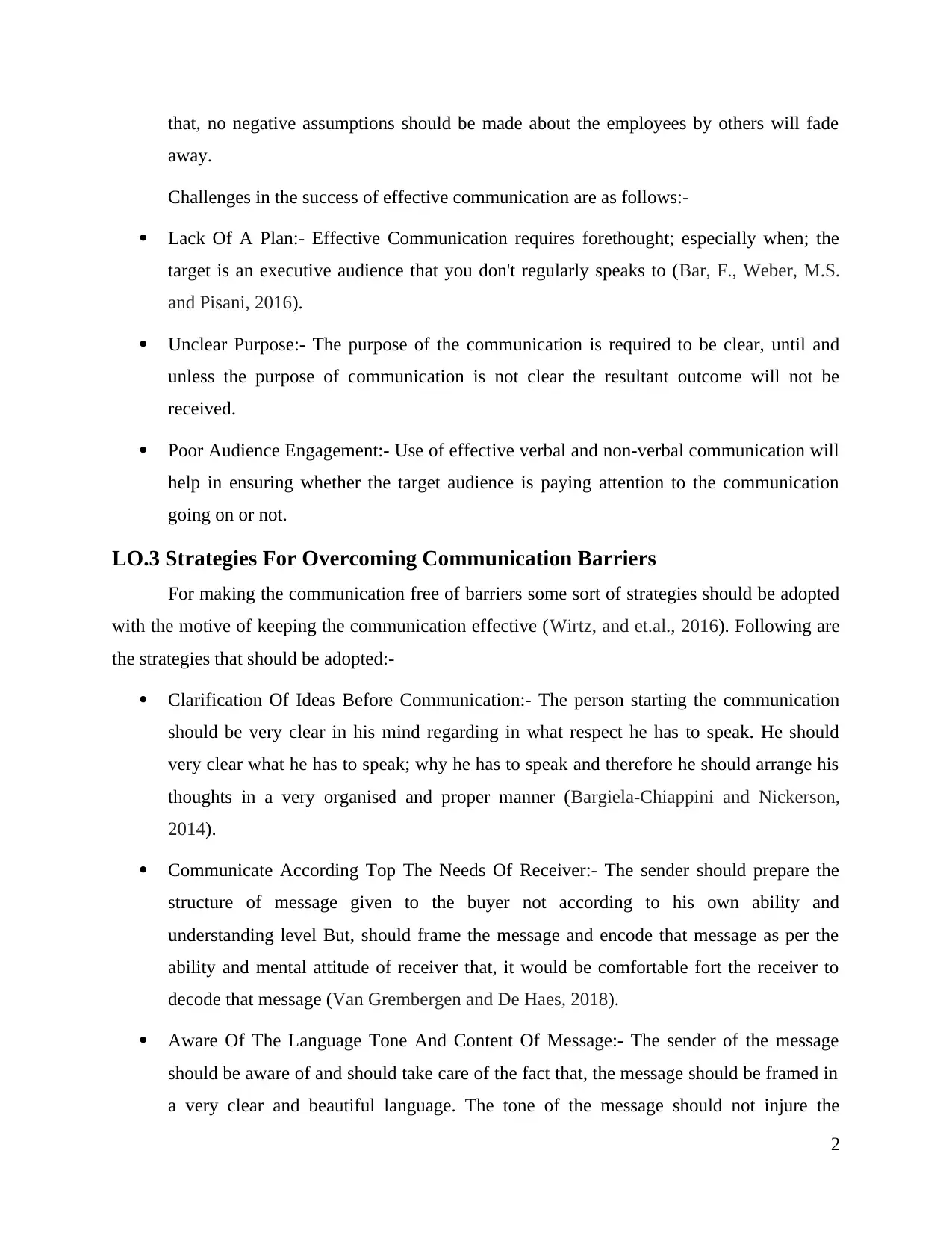
that, no negative assumptions should be made about the employees by others will fade
away.
Challenges in the success of effective communication are as follows:-
Lack Of A Plan:- Effective Communication requires forethought; especially when; the
target is an executive audience that you don't regularly speaks to (Bar, F., Weber, M.S.
and Pisani, 2016).
Unclear Purpose:- The purpose of the communication is required to be clear, until and
unless the purpose of communication is not clear the resultant outcome will not be
received.
Poor Audience Engagement:- Use of effective verbal and non-verbal communication will
help in ensuring whether the target audience is paying attention to the communication
going on or not.
LO.3 Strategies For Overcoming Communication Barriers
For making the communication free of barriers some sort of strategies should be adopted
with the motive of keeping the communication effective (Wirtz, and et.al., 2016). Following are
the strategies that should be adopted:-
Clarification Of Ideas Before Communication:- The person starting the communication
should be very clear in his mind regarding in what respect he has to speak. He should
very clear what he has to speak; why he has to speak and therefore he should arrange his
thoughts in a very organised and proper manner (Bargiela-Chiappini and Nickerson,
2014).
Communicate According Top The Needs Of Receiver:- The sender should prepare the
structure of message given to the buyer not according to his own ability and
understanding level But, should frame the message and encode that message as per the
ability and mental attitude of receiver that, it would be comfortable fort the receiver to
decode that message (Van Grembergen and De Haes, 2018).
Aware Of The Language Tone And Content Of Message:- The sender of the message
should be aware of and should take care of the fact that, the message should be framed in
a very clear and beautiful language. The tone of the message should not injure the
2
away.
Challenges in the success of effective communication are as follows:-
Lack Of A Plan:- Effective Communication requires forethought; especially when; the
target is an executive audience that you don't regularly speaks to (Bar, F., Weber, M.S.
and Pisani, 2016).
Unclear Purpose:- The purpose of the communication is required to be clear, until and
unless the purpose of communication is not clear the resultant outcome will not be
received.
Poor Audience Engagement:- Use of effective verbal and non-verbal communication will
help in ensuring whether the target audience is paying attention to the communication
going on or not.
LO.3 Strategies For Overcoming Communication Barriers
For making the communication free of barriers some sort of strategies should be adopted
with the motive of keeping the communication effective (Wirtz, and et.al., 2016). Following are
the strategies that should be adopted:-
Clarification Of Ideas Before Communication:- The person starting the communication
should be very clear in his mind regarding in what respect he has to speak. He should
very clear what he has to speak; why he has to speak and therefore he should arrange his
thoughts in a very organised and proper manner (Bargiela-Chiappini and Nickerson,
2014).
Communicate According Top The Needs Of Receiver:- The sender should prepare the
structure of message given to the buyer not according to his own ability and
understanding level But, should frame the message and encode that message as per the
ability and mental attitude of receiver that, it would be comfortable fort the receiver to
decode that message (Van Grembergen and De Haes, 2018).
Aware Of The Language Tone And Content Of Message:- The sender of the message
should be aware of and should take care of the fact that, the message should be framed in
a very clear and beautiful language. The tone of the message should not injure the
2
Paraphrase This Document
Need a fresh take? Get an instant paraphrase of this document with our AI Paraphraser
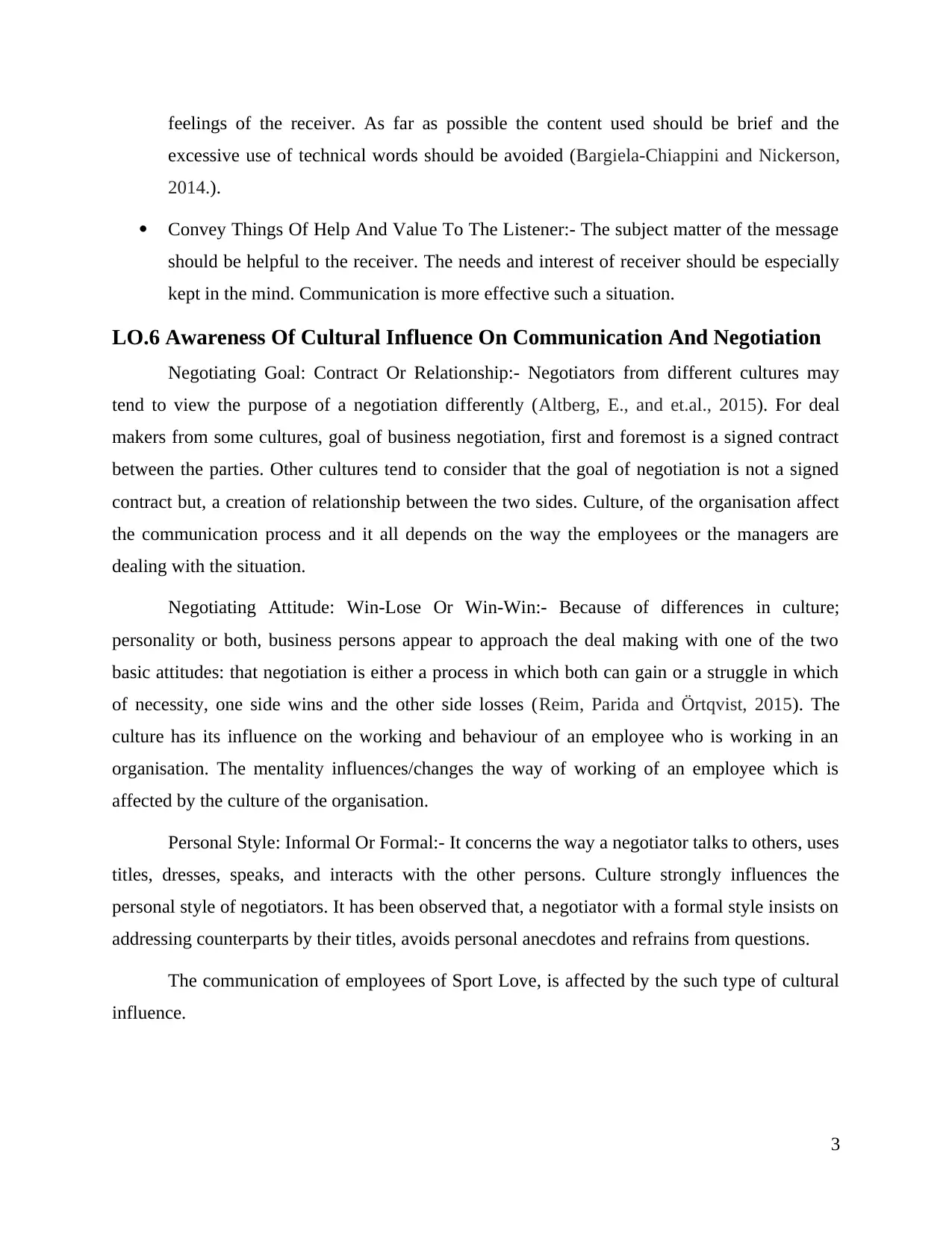
feelings of the receiver. As far as possible the content used should be brief and the
excessive use of technical words should be avoided (Bargiela-Chiappini and Nickerson,
2014.).
Convey Things Of Help And Value To The Listener:- The subject matter of the message
should be helpful to the receiver. The needs and interest of receiver should be especially
kept in the mind. Communication is more effective such a situation.
LO.6 Awareness Of Cultural Influence On Communication And Negotiation
Negotiating Goal: Contract Or Relationship:- Negotiators from different cultures may
tend to view the purpose of a negotiation differently (Altberg, E., and et.al., 2015). For deal
makers from some cultures, goal of business negotiation, first and foremost is a signed contract
between the parties. Other cultures tend to consider that the goal of negotiation is not a signed
contract but, a creation of relationship between the two sides. Culture, of the organisation affect
the communication process and it all depends on the way the employees or the managers are
dealing with the situation.
Negotiating Attitude: Win-Lose Or Win-Win:- Because of differences in culture;
personality or both, business persons appear to approach the deal making with one of the two
basic attitudes: that negotiation is either a process in which both can gain or a struggle in which
of necessity, one side wins and the other side losses (Reim, Parida and Örtqvist, 2015). The
culture has its influence on the working and behaviour of an employee who is working in an
organisation. The mentality influences/changes the way of working of an employee which is
affected by the culture of the organisation.
Personal Style: Informal Or Formal:- It concerns the way a negotiator talks to others, uses
titles, dresses, speaks, and interacts with the other persons. Culture strongly influences the
personal style of negotiators. It has been observed that, a negotiator with a formal style insists on
addressing counterparts by their titles, avoids personal anecdotes and refrains from questions.
The communication of employees of Sport Love, is affected by the such type of cultural
influence.
3
excessive use of technical words should be avoided (Bargiela-Chiappini and Nickerson,
2014.).
Convey Things Of Help And Value To The Listener:- The subject matter of the message
should be helpful to the receiver. The needs and interest of receiver should be especially
kept in the mind. Communication is more effective such a situation.
LO.6 Awareness Of Cultural Influence On Communication And Negotiation
Negotiating Goal: Contract Or Relationship:- Negotiators from different cultures may
tend to view the purpose of a negotiation differently (Altberg, E., and et.al., 2015). For deal
makers from some cultures, goal of business negotiation, first and foremost is a signed contract
between the parties. Other cultures tend to consider that the goal of negotiation is not a signed
contract but, a creation of relationship between the two sides. Culture, of the organisation affect
the communication process and it all depends on the way the employees or the managers are
dealing with the situation.
Negotiating Attitude: Win-Lose Or Win-Win:- Because of differences in culture;
personality or both, business persons appear to approach the deal making with one of the two
basic attitudes: that negotiation is either a process in which both can gain or a struggle in which
of necessity, one side wins and the other side losses (Reim, Parida and Örtqvist, 2015). The
culture has its influence on the working and behaviour of an employee who is working in an
organisation. The mentality influences/changes the way of working of an employee which is
affected by the culture of the organisation.
Personal Style: Informal Or Formal:- It concerns the way a negotiator talks to others, uses
titles, dresses, speaks, and interacts with the other persons. Culture strongly influences the
personal style of negotiators. It has been observed that, a negotiator with a formal style insists on
addressing counterparts by their titles, avoids personal anecdotes and refrains from questions.
The communication of employees of Sport Love, is affected by the such type of cultural
influence.
3
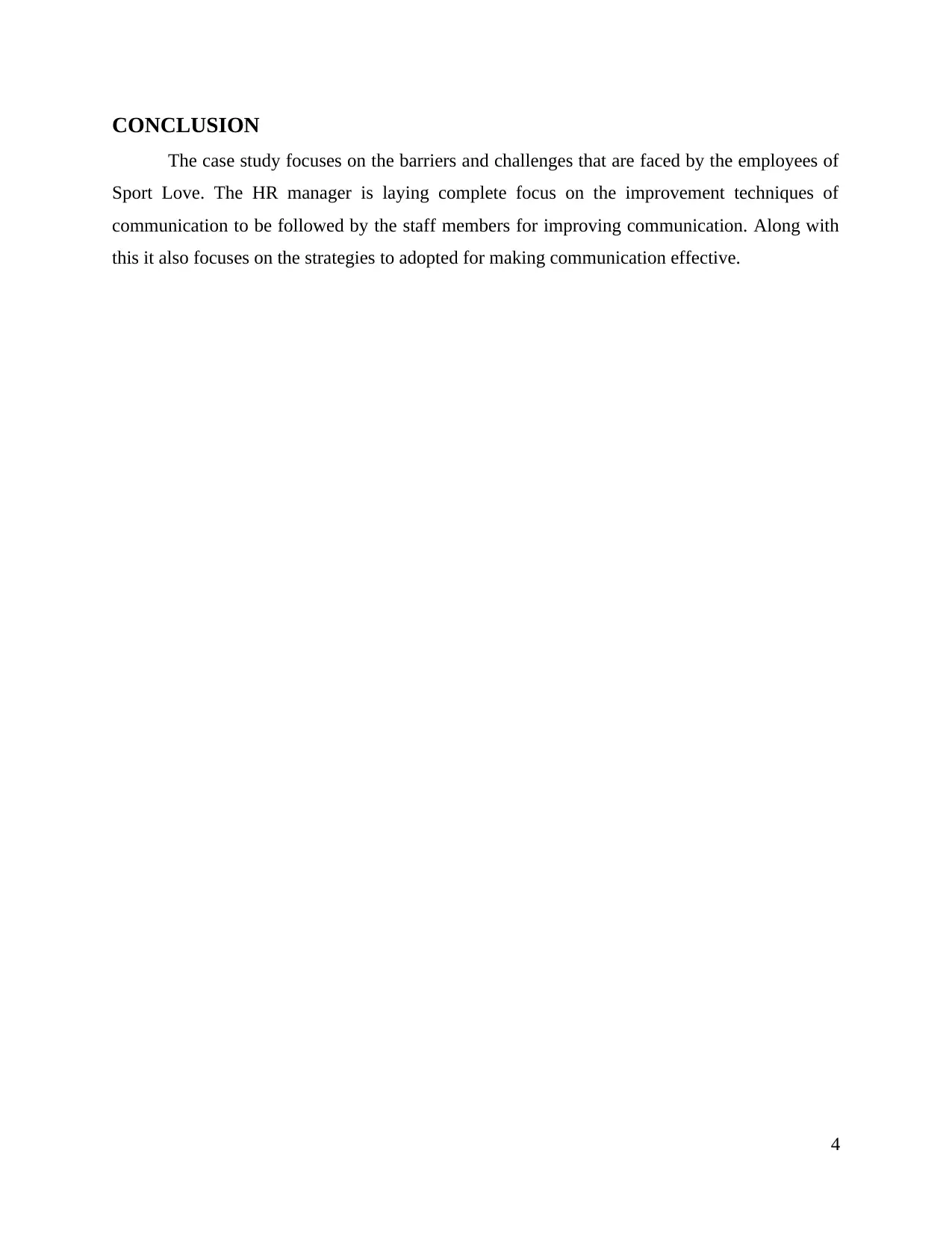
CONCLUSION
The case study focuses on the barriers and challenges that are faced by the employees of
Sport Love. The HR manager is laying complete focus on the improvement techniques of
communication to be followed by the staff members for improving communication. Along with
this it also focuses on the strategies to adopted for making communication effective.
4
The case study focuses on the barriers and challenges that are faced by the employees of
Sport Love. The HR manager is laying complete focus on the improvement techniques of
communication to be followed by the staff members for improving communication. Along with
this it also focuses on the strategies to adopted for making communication effective.
4
⊘ This is a preview!⊘
Do you want full access?
Subscribe today to unlock all pages.

Trusted by 1+ million students worldwide
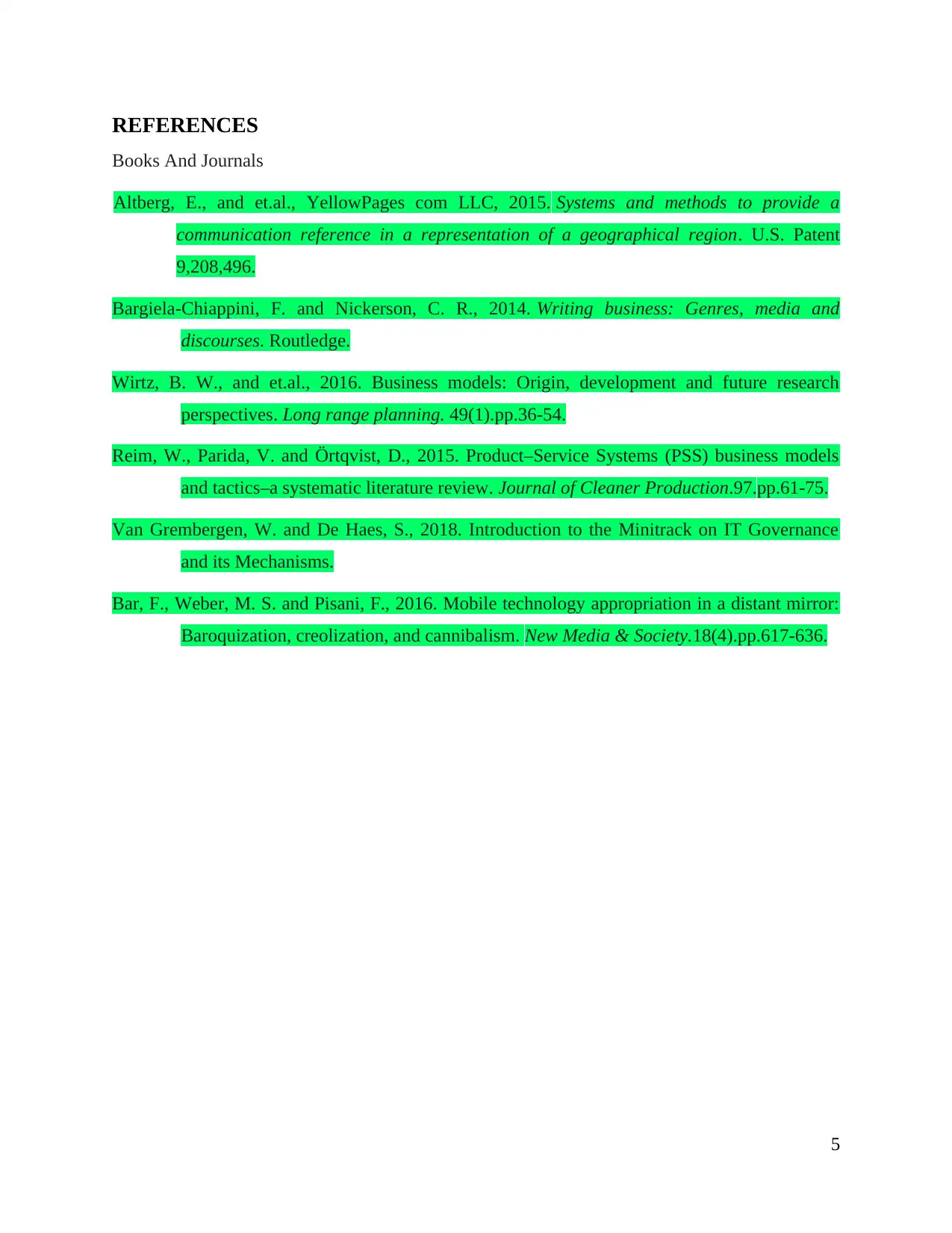
REFERENCES
Books And Journals
Altberg, E., and et.al., YellowPages com LLC, 2015. Systems and methods to provide a
communication reference in a representation of a geographical region. U.S. Patent
9,208,496.
Bargiela-Chiappini, F. and Nickerson, C. R., 2014. Writing business: Genres, media and
discourses. Routledge.
Wirtz, B. W., and et.al., 2016. Business models: Origin, development and future research
perspectives. Long range planning. 49(1).pp.36-54.
Reim, W., Parida, V. and Örtqvist, D., 2015. Product–Service Systems (PSS) business models
and tactics–a systematic literature review. Journal of Cleaner Production.97.pp.61-75.
Van Grembergen, W. and De Haes, S., 2018. Introduction to the Minitrack on IT Governance
and its Mechanisms.
Bar, F., Weber, M. S. and Pisani, F., 2016. Mobile technology appropriation in a distant mirror:
Baroquization, creolization, and cannibalism. New Media & Society.18(4).pp.617-636.
5
Books And Journals
Altberg, E., and et.al., YellowPages com LLC, 2015. Systems and methods to provide a
communication reference in a representation of a geographical region. U.S. Patent
9,208,496.
Bargiela-Chiappini, F. and Nickerson, C. R., 2014. Writing business: Genres, media and
discourses. Routledge.
Wirtz, B. W., and et.al., 2016. Business models: Origin, development and future research
perspectives. Long range planning. 49(1).pp.36-54.
Reim, W., Parida, V. and Örtqvist, D., 2015. Product–Service Systems (PSS) business models
and tactics–a systematic literature review. Journal of Cleaner Production.97.pp.61-75.
Van Grembergen, W. and De Haes, S., 2018. Introduction to the Minitrack on IT Governance
and its Mechanisms.
Bar, F., Weber, M. S. and Pisani, F., 2016. Mobile technology appropriation in a distant mirror:
Baroquization, creolization, and cannibalism. New Media & Society.18(4).pp.617-636.
5
1 out of 7
Related Documents
Your All-in-One AI-Powered Toolkit for Academic Success.
+13062052269
info@desklib.com
Available 24*7 on WhatsApp / Email
![[object Object]](/_next/static/media/star-bottom.7253800d.svg)
Unlock your academic potential
Copyright © 2020–2025 A2Z Services. All Rights Reserved. Developed and managed by ZUCOL.





